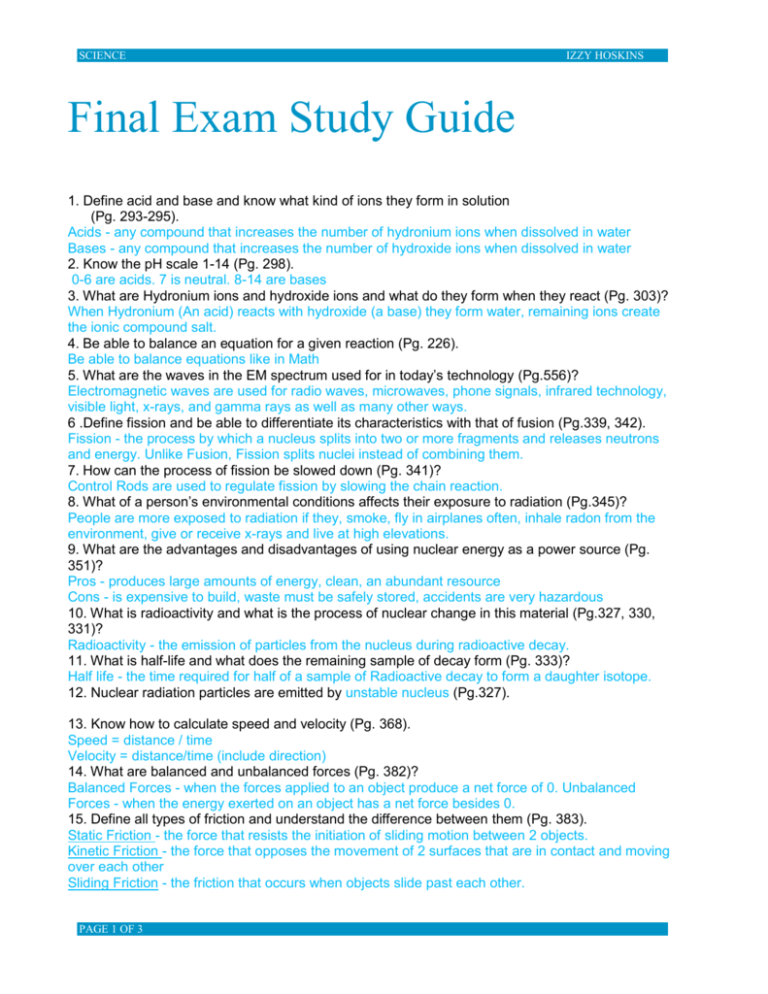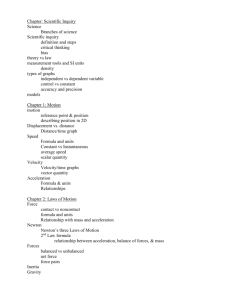Final Exam Study Guide
advertisement

SCIENCE IZZY HOSKINS Final Exam Study Guide 1. Define acid and base and know what kind of ions they form in solution (Pg. 293-295). Acids - any compound that increases the number of hydronium ions when dissolved in water Bases - any compound that increases the number of hydroxide ions when dissolved in water 2. Know the pH scale 1-14 (Pg. 298). 0-6 are acids. 7 is neutral. 8-14 are bases 3. What are Hydronium ions and hydroxide ions and what do they form when they react (Pg. 303)? When Hydronium (An acid) reacts with hydroxide (a base) they form water, remaining ions create the ionic compound salt. 4. Be able to balance an equation for a given reaction (Pg. 226). Be able to balance equations like in Math 5. What are the waves in the EM spectrum used for in today’s technology (Pg.556)? Electromagnetic waves are used for radio waves, microwaves, phone signals, infrared technology, visible light, x-rays, and gamma rays as well as many other ways. 6 .Define fission and be able to differentiate its characteristics with that of fusion (Pg.339, 342). Fission - the process by which a nucleus splits into two or more fragments and releases neutrons and energy. Unlike Fusion, Fission splits nuclei instead of combining them. 7. How can the process of fission be slowed down (Pg. 341)? Control Rods are used to regulate fission by slowing the chain reaction. 8. What of a person’s environmental conditions affects their exposure to radiation (Pg.345)? People are more exposed to radiation if they, smoke, fly in airplanes often, inhale radon from the environment, give or receive x-rays and live at high elevations. 9. What are the advantages and disadvantages of using nuclear energy as a power source (Pg. 351)? Pros - produces large amounts of energy, clean, an abundant resource Cons - is expensive to build, waste must be safely stored, accidents are very hazardous 10. What is radioactivity and what is the process of nuclear change in this material (Pg.327, 330, 331)? Radioactivity - the emission of particles from the nucleus during radioactive decay. 11. What is half-life and what does the remaining sample of decay form (Pg. 333)? Half life - the time required for half of a sample of Radioactive decay to form a daughter isotope. 12. Nuclear radiation particles are emitted by unstable nucleus (Pg.327). 13. Know how to calculate speed and velocity (Pg. 368). Speed = distance / time Velocity = distance/time (include direction) 14. What are balanced and unbalanced forces (Pg. 382)? Balanced Forces - when the forces applied to an object produce a net force of 0. Unbalanced Forces - when the energy exerted on an object has a net force besides 0. 15. Define all types of friction and understand the difference between them (Pg. 383). Static Friction - the force that resists the initiation of sliding motion between 2 objects. Kinetic Friction - the force that opposes the movement of 2 surfaces that are in contact and moving over each other Sliding Friction - the friction that occurs when objects slide past each other. PAGE 1 OF 3 SCIENCE IZZY HOSKINS Rolling Friction - the friction on a round object rolling across a surface (less than Sliding) 16. Know what kind of units give the most accurate measure of speed and time(Pg.368). The smaller the time/distance units are the more accurate 17. Understand examples of positive vs. negative acceleration (Pg.372-375). Positive Acceleration is when the speed increases in the direction of the motion. Negative Acceleration is a decrease of speed in the opposite direction of the motion. 18. Understand how mass and distance are related to gravity (Pg. 403-405). The greater an objects mass is the more pull gravity has on it. The farther away two objects are the less gravity between them 19. What is universal gravitation (Pg. 405)? Universal Gravitation is the law that states that all objects in the universe attract each other through the force of gravity. Equation - F= G ( m1-m2)/( d squared) 20. What is the rate of gravity on Earth (Pg. 403)? 9.8m/s squared 21. Know Newton’s 3 Laws of Motion (Pg. 397, 400, 402). Law 1 - An object at rest/in motion remains at rest/in motion unless it is acted on by a foreign force Law 2 - The unbalanced force acting on an object equals the object’s mass times its acceleration Law 3 - the acceleration of an object is directly proportional to the net force on the object and inversely proportional to the object’s mass. 22. What affects an object inertia (Pg. 338) Inertia is affected by mass. 23. What is terminal velocity (Pg. 407) Terminal Velocity - the constant velocity of a falling object when the force of air resistance is equal in magnitude and opposite in direction to the force of gravity. 24. What is the Law of Conservation of Momentum (Pg. 416)? The Law of Conservation of Momentum - The total amount of momentum in an isolated system is conserved 25. Be able to manipulate F=ma, S=d/t and W=mg (Pg. 400,368,403). Force=mass*acceleration, Weight = mass*gravity, Speed = distance/time 26. Be able to identify and differentiate between radiation, convection and conduction (Pg.481482). Radiation - the energy that is transferred as electromagnetic waves (visible light and infrared rays) Convection - the movement of matter due to differences in density that are caused by temperature variations Conduction - the transfer of heat energy through a material 27. Be able to convert temperatures between Kelvin, Fahrenheit and Celsius (Pg. 473-477). Fahrenheit temp.= (1.8 * Celsius) + 32 Kelvin = Celsius temp. = 27 28. Know the differences and similarities of wave types and their interactions with each other (Pg 505-513). Mechanical Waves - waves that require a medium Electromagnetic Waves a wave without a medium that consists of oscillating electric and magnetic field which radiate outward at the speed of light. Transverse Waves - waves in which the particles of the medium move perpendicularly to the direction the wave is traveling Longitudinal Waves- waves in which the particles of the medium move perpendicularly to the direction the wave is traveling Surface Waves – a combination of Longitudinal waves and transverse waves that occur between two mediums. PAGE 2 OF 3 SCIENCE IZZY HOSKINS 29. Know the parts of a wave i.e. crest, trough, resting point, amplitude and period (Pg.512, 514515 ). Crest - the highest point of a wave. Trough - the lowest point of wave Resting Point - the center of a wave Amplitude - the maximum distance that the particles of a wave’s medium vibrate from the rest position. Period - the time it takes a complete cycle or wave oscillation to occur 30. Be able to calculate frequency, wavelength and wave speed (Pg. 515-519). 31. Describe Doppler Effect (Pg. 522-523). the Doppler effect is an observed change in the frequency of a wave when the source or observer is moving 32. What evidence leads scientists to believe in Continental Drift? What is the cause (Pg. 731-733)? Alignment of oceanic rocks supports the theory of moving plates as well as the discovery of prehistoric fossils of animals that didn’t migrate on multiple continents. 33. What are the 3 types of plate tectonics (Pg.734-737)? Convergent, Divergent, and Transforming/Sliding. 34. What are the 3 types of volcanoes (Pg. 743-744)? Shield Volcano, Composite Volcano and Cinder cone 35. Understand the Rock Cycle. What are the 3 types of rocks (Pg. 748-752)? Sedimentary, Igneous, and Metamorphic. 36. Know and understand the Life Cycle of a Star (698-699). Go to Life Cycle of a Star Sheet 37. Know the location of the Sun in the Star Life Cycle and the projected path of the Sun (Pg.698699). The Sun is currently a Red Giant. It doesn’t have the mass to become a supernova, so it will most likely become a White Dwarf. PAGE 3 OF 3






